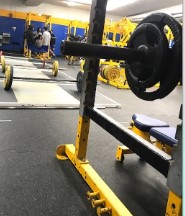Teen Health Starts Within
Teenage years are the start of healthy habits that most will carry into adulthood. Making time for simple changes can overall improve a teen’s quality of life and reduce the risk of developing issues in the future.

San Pasqual High School’s weight room. Photo credit: Briana Le
October 14, 2020
Teenage years are the start of healthy habits that most will carry into adulthood. Making time for simple changes can overall improve a teen’s quality of life and reduce the risk of developing issues in the future.
The life of a busy teen in high school usually consists of waking up, going to a long day of school, coming home to do more work, then going to sleep. With tedious schedules filling up every day, it’s difficult for many teens to focus on their health. The main three necessities to maintain a healthy lifestyle for any teenager are eating, drinking, and moving.
“About 20 percent of kids between 12 and 19 years old have obesity. But small changes in your eating and physical activity habits may help,” says a teen health guide from The National Institute of Diabetes and Digestive and Kidney Diseases.
Maintaining a good diet is the most simple of the factors to incorporate into a teen’s life. Most people know to incorporate fruits and vegetables, but some of the most important foods are overlooked. Being told to consume a balance of carbs, fats, vegetables, fruits, and proteins, while limiting sugar, can sometimes get confusing. Like the difference between good fats and bad fats, but it’s actually easy to notice when teens frequently check the nutritional label.
“Processed foods, like those that are canned or packaged, often have more sodium than unprocessed foods… remember to rinse canned vegetables with water to remove extra salt. If you use packaged foods, check the amount of sodium listed on the Nutrition Facts label,” says The National Institute of Diabetes and Digestive and Kidney Diseases.
Fats with oil that come from plants are better than solid fats. Oily fats are liquid at room temperature while solid fats that contain saturated and trans fats are solid at room temperature. For grains, stick to whole-wheat, oatmeal, and whole-grain cereal instead of foods like white bread or white rice. While any teens understand that lean meat is a better option, other protein-rich foods include seafood, nuts, beans, and egg whites. Lastly is dairy, a non-essential option but builds strong bones. Even if someone can’t digest lactose, there are lactose-free options that give the same benefits important for developing growth. But low-fat and fat-free dairy is recommended for a better diet.
“There are certain diseases and illnesses that are affected by your lifestyle, and what you eat and exercise. So things like diabetes… obesity… cardiovascular disease… and good patterns are started early on in high school… you want to start doing things that will continue on for the rest of your life. If you need help [with your weight] then I think that it’s important to talk to your doctor or someone that can guide you properly,” says Caroline Akers, the nurse at San Pasqual High School.
Water is a necessity, but many teens don’t consume the minimum daily amount. According to an informational article on Healthy Kids, water helps the body function at its full potential. Dehydration is common among teens and is less easily recognized as they grow into an adult. Because of this, it’s best to start a healthy habit of drinking at least 7 cups of water each day to avoid headaches, fatigue, inability to concentrate, and poor athletic performance.
Active teens need to make sure they drink water before, during, and after anything physical in order to put back the water lost from sweat and even just breathing.
“Water helps keep your body’s temperature stable, it carries nutrients and oxygen to cells, cushions joints, protects organs and tissues and removes wastes,” says Healthy Kids, a health website and tool that helps guide teens and children to live a healthy lifestyle.
Physical fitness is the last step to maintain good health. For teens, it can be difficult to find time to do some form of physical fitness during the school week. Having a gym membership can enable teens to go workout, but there are definitely budget-friendly options right at San Pasqual High School.The school has its own skateboarding club which is a great way to not only exercise, but get involved with the school. San Pasqual also has utilities open after and before school such as the weight room and the track. Akers reveals that doing weight lifting increases muscle mass while also burning calories, even at rest! Kit Carson park is also a great place to walk or go jogging, and it’s easily accessible because of its relative distance from the school. There are many ways for teens to stay active, even if they have a busy schedule! And with a good mindset and mental motivation, the path to a healthier lifestyle begins.
“I saw how much junk food I would eat like every day after school and it kind of disappointed me… I wanted to make better decisions… The habits that you make right now are going to set you up for the future,” says 9th grader Kelsey Perez, a student who changed her lifestyle for the better.


